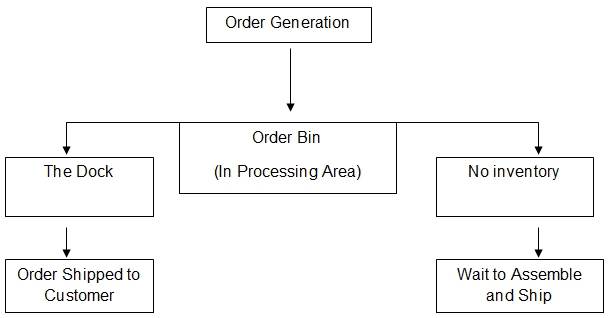Customers’ Complaints & OFC’s Measure of Efficiency
From the case study, it is evident that customers of Euro Computer Systems (ECS) are upset due to an underperforming Order Fulfillment Center (OFC) as demonstrated by the delay in the delivery of computer terminal components to them.
The customers’ complaints are justified because the order fill rate (completed orders filed on time) is 43 percent, implying that most customers have to contend with the problem of getting the highly specialized components long after the computers are delivered.
An effectively operating OFC should have the capacity not only to meet specific ordering and distribution needs as demanded by customers, but also to ensure cost savings and substantially reduce customer complaints.
Description of Current Process and Problems
The current process in the OFC is largely manual-based, and involves generating the orders on a weekly basis, dating the orders and putting them in an Order Bin located in the order processing area, entering the numbers from the order form into the computer to identify the location of terminals, pulling out the terminals if available, and taking the terminals into a central processing location called the dock for onward shipping (see Figure 1).
The problems with the current process are nested in (1) the use of different means to locate the terminals and forward them for onward shipping, and (2) the lack of uniformity in the recording of order shortages.
Order Generation Figure 1: Process Flow Diagram

General Changes
The terminals requested by customers are highly specialized due to security concerns, hence the decision by management to implement a low stock policy not only to minimize inventory costs but also to lower the costs involved in discarding obsolete terminals. Consequently, a short term change to improve performance could be to streamline the process involved in the recording of shortages with the view to substantially reducing the amount of time taken to replenish the inventory for missing orders.
A long term change could be to fully computerize OFC not only to harmonize the different avenues presently used to locate the terminals from the inventory area but also to ensure that stocks are replenished as soon as possible to meet customer demands. Consequently, the performance in the OFC could be measured in terms of achieving a high order fill rate (above 80 percent), ensuring the stored inventory can successfully meet customer demands without elevating cost overruns, and also maximizing customer satisfaction levels.
Additional Information for Complete OFC Redesign
A complete redesigning of the OFC process to improve performance needs much more information than is currently available. For example, the information on the availability and nature of inventory needs to be availed to inform efficient replenishment practice. The information filled on the order card should also be availed to shed light on how missing orders are documented and who is responsible for ensuring these components are replenished at the earliest convenience.
Additionally, information on what has already been computerized, and what is done manually should be availed to assist stakeholders in deciding what more should be computerized to improve efficiency and performance. Lastly, information on all the employees/players working in the OFC and their specific roles should be provided to ensure seamless integration of all processes and activities with the view to substantially reducing customer wait times after making an order.